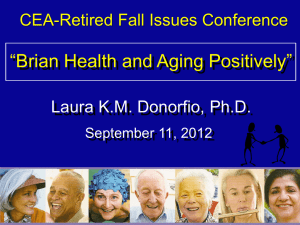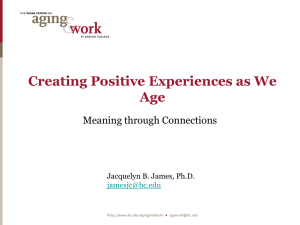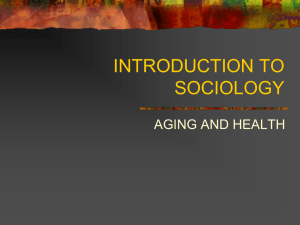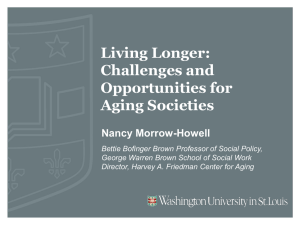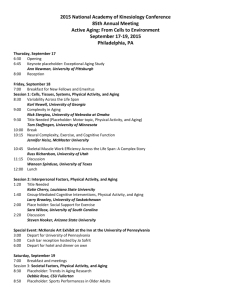Aging Theories - WordPress.com
advertisement
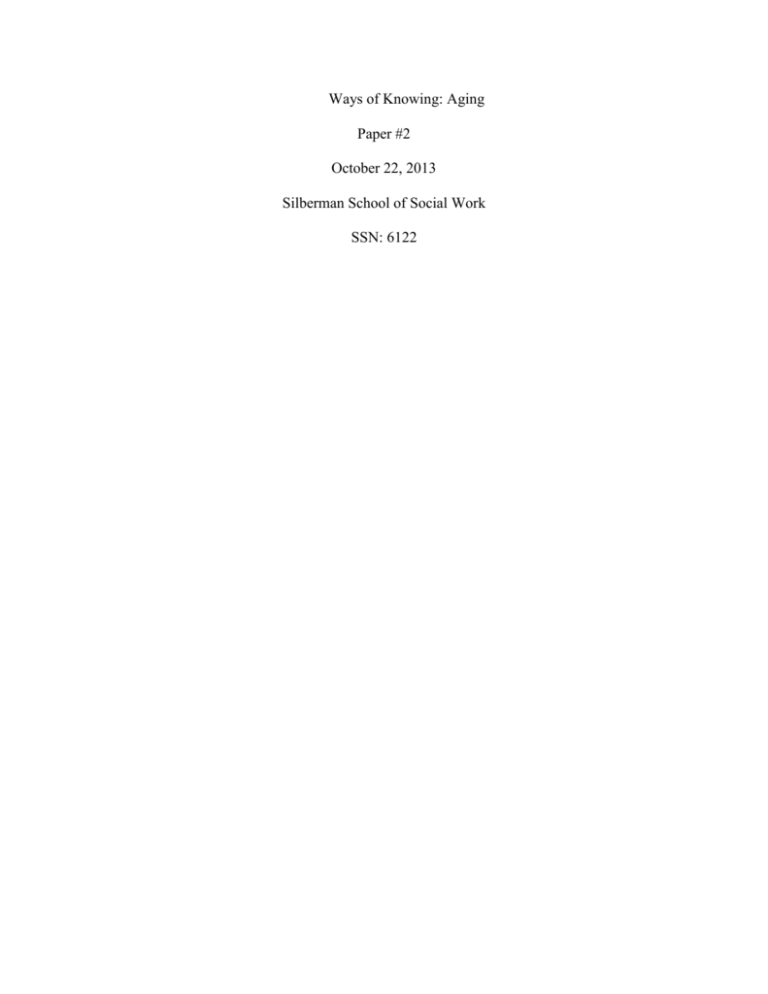
Ways of Knowing: Aging Paper #2 October 22, 2013 Silberman School of Social Work SSN: 6122 Aging is a complex process, both physically and mentally. Since the 1950’s, researchers have attempted to deconstruct the enigmatic relationship between the mind and the process of aging. Multiple theories offer varying perspectives on assisting elders maintain a high quality of life despite their advanced age. The two most prevalent sociologically based theories on aging are “continuity theory” and “disengagement theory.” These two hypotheses approach the complicated issue of aging in starkly differing methods. A close examination of continuity and disengagement theories may help practitioners more fully understand the nuances within the field of aging and consequently assist their clients utilizing more effective techniques. Disengagement theory was among the first major theories in aging emerging in the 1960s. Cumming and Henry contend individuals must accept their inevitably natural decline. Cumming and Henry define disengagement as the gradual withdrawal from society as someone ages (Lynott & Lynott 1996). They argue it is in the best interest of the individual and of society to withdraw in an effort to leave society undisturbed and sustain one’s peace of mind. I witnessed the behavior Cumming and Henry articulate when my paternal grandfather began his retirement. He ran a real estate practice in New Jersey for over fifty years. However, over time he slowly relinquished most of the administrative responsibilities to a senior employee. Eventually he was able to step out of the spotlight and retire—knowing that his successor had the tools for success. He soon followed suit with his finances: gradually allowing my father to manage such matters. My grandfather is now 85 years old, experiencing early stages of Alzheimer’s and the benefits of disengagement. He did not postpone his disengagement until it was absolutely crucial, instead opting to give his responsibilities to trusted individuals over several years. For Cumming and Henry, gradual and incremental disengagement is the most effective and beneficial way of addressing aging since it allows an individual to adjust to their condition comfortably, rather than abruptly withdrawing from the world due to external factors such as illness: like my grandfather’s Alzheimer’s. There is however another methodology of dealing with aging—continuity theory, which stands in opposition to disengagement theory. Continuity theorists argue it is crucial for an aging person to continue to live life as they did prior to their status as an elderly person. Continuity theorists view life as a journey, continuously chancing and as such, people must adapt to old age, lifestyle changes must only take place under extreme necessity. It can be beneficial for a senior to continue living as if nothing has changed (Parker 1995). That is to say, one must be able to preserve a sense of self and existing social structure in the midst of old age. Elderly individuals should simply continue to live as they have done before, without factoring age into the metaphorical equation unless a situation warrants it. When my maternal grandfather reached his 80s, he did not alter his lifestyle. He had retired years earlier but continued to conduct himself as he was accustomed to do. He attended lectures at Rutgers University, went to cultural events in New York City, and drove a car up until the very end of his life. The cause of his death was simply old age yet my grandfather never allowed his age to prevent him from doing as he pleased. He lived unaffected by his advancing age and as therefore appeared to live very fully and happily fur the duration of his life. Continuity theorists believe the key to happiness in old age is staying true to oneself: simply put, doing the activities an individual has loved regardless of age (Parker 1995). These theories, though disparate, have both proven to be effective. That said however, a critical evaluation of said theories is needed to highlight the particular pros and cons of each. Critics of disengagement theory are critical of its emphasis on social systems rather than the individual (Lynott & Lynott 1996). Social researchers have suggested that aging is an individualized social issue that needs to be addressed on an individualized basis (Lynott & Lynott 1996). One of the main arguments against disengagement theory is the tendency to generalize the process of aging as a uniform societal experience. Rather, aging must be evaluated in a context of the individual and his or her personal history. Critics of disengagement theory claim the diversity and variation in the aging process can have a wide scope of manifestations: such manifestations may derive from culture, gender and class (Achenbaum & Bengston 1994). “Subcultures” of aging illuminate the ways in which particular groups handle aging differently (Lynott 1996). Disengagement theory can be especially challenging for a senior individual, in fact, might make one’s situation more stressful to cope with. Critics of disengagement theory contend no two seniors experience aging in the exact same way. Social scientists have employed this contention therefore, to undermine the necessity of withdrawing as one ages. Proponents of disengagement theory view aging as a natural process: occurring organically as someone gets older (Achenbaum & Bengston 1994). This upends the notion that the individual should continue living life sans any disengagement. Cumming and Henry believe “biology is destiny” (Achenbaum & Bengston 1994). This idea is directly at odds continuity theory as it factors in the biological restrictions of aging. It is evitable that physical and cognitive abilities must decline with age, and critics of continuity theory claim seniors must not fight back against such processes. It may prove detrimental to one’s health and mental wellbeing to push oneself beyond reasonable limits. Continuity theory does not accept the limits of nature and therefore can be a dangerous course of aging. I believe the principle problem of each theory is their emphasis on absolutes. I agree with the idea espoused by critics of disengagement theory. All seniors are different and can handle aging differently. For someone like my paternal grandfather, he had no choice but to disengage. Though he didn’t know it at the time, he was making a very prudent decision to hand over his responsibilities. If he had not disengaged, he would have had to make serious life decisions while suffering from the early symptoms of Alzheimer’s disease. However, my maternal grandfather made the right decision for himself by not disengaging. His health was not rapidly declining and his cognitive abilities stayed sharp until his death at the age of 90. For my maternal grandfather, there was no point in preparing for the end of his life. He was happy and able to do what he wanted; it would have been detrimental to force him into disengagement. If I were a practicing gerontological social worker, I would choose neither disengagement theory nor continuity theory as an absolute truth in my practice. Aging is a complex and individualized issue. What’s more, theories are just that—theoretical claims, not definitive facts. It is easy to see that all people are different and age very differently; there can be no “one size fits all” approach when dealing with aging. Thus, no singular theory in isolation can fully explain the best way to handle the aging process. If continuity is possible, it is one means of maintaining happiness later in life. Alternatively, if it is not possible, disengagement is crucial for ensuring that seniors do injure themselves due to an underlying condition. For seniors with dementia, any work or serious responsibility is surely impossible. In other words, a decision such as this should be made the senior, family members, and the social worker. There is no easy answer to aging and the analyses of these two theories further prove that the aging process is not uniform. Works Cited Achenbaum, W. Andrew & Bengston, Vern (1994). Re-engaging the Disengagement Theory of Aging: On the History and Assessment of Theory Development in Gerontology. The Gerontologist, Vol 34, No 6, 756-763. Lynott, Robert & Lynott Patricia (1996). Tracing the Course of Theoretical Development in the Sociology of Aging. The Gerontologist, Vol 36, No 6, 749-760. Parker, Rhonda (1995). Reminiscence: A Continuity Theory Framework. The Gerontologist, Vol 35, No 5, 515-531.

